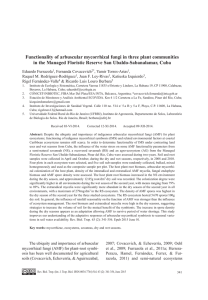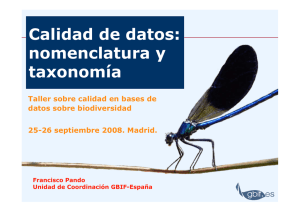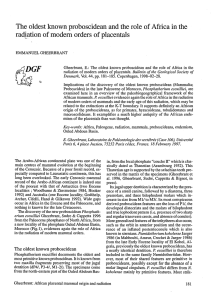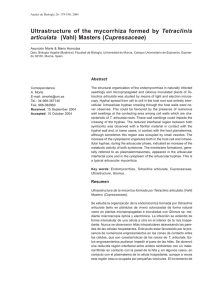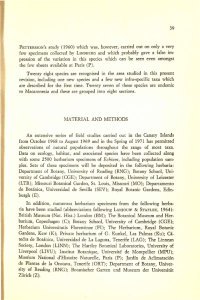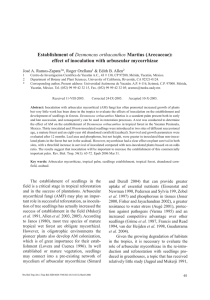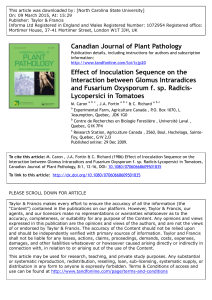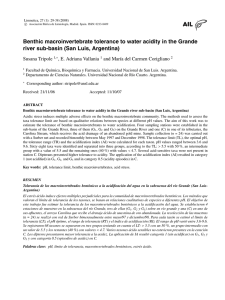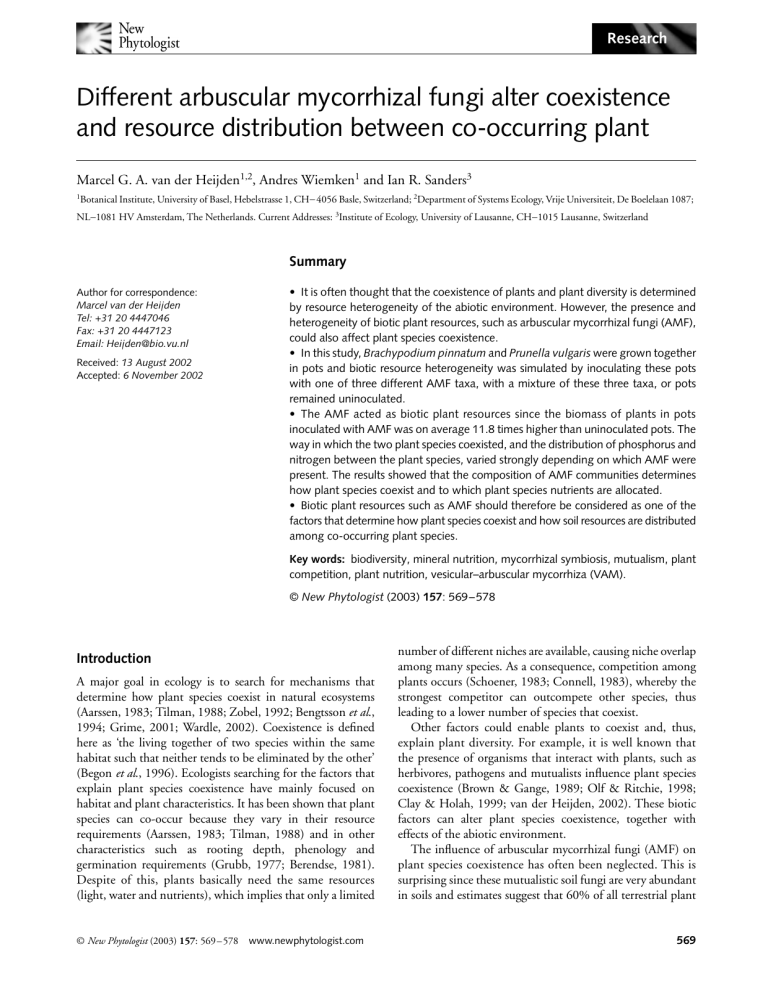
Research Different arbuscular mycorrhizal fungi alter coexistence and resource distribution between co-occurring plant Blackwell Publishing Ltd. Marcel G. A. van der Heijden1,2, Andres Wiemken1 and Ian R. Sanders3 Botanical Institute, University of Basel, Hebelstrasse 1, CH− 4056 Basle, Switzerland; 2Department of Systems Ecology, Vrije Universiteit, De Boelelaan 1087; 1 NL−1081 HV Amsterdam, The Netherlands. Current Addresses: 3Institute of Ecology, University of Lausanne, CH−1015 Lausanne, Switzerland Summary Author for correspondence: Marcel van der Heijden Tel: +31 20 4447046 Fax: +31 20 4447123 Email: [email protected] Received: 13 August 2002 Accepted: 6 November 2002 • It is often thought that the coexistence of plants and plant diversity is determined by resource heterogeneity of the abiotic environment. However, the presence and heterogeneity of biotic plant resources, such as arbuscular mycorrhizal fungi (AMF), could also affect plant species coexistence. • In this study, Brachypodium pinnatum and Prunella vulgaris were grown together in pots and biotic resource heterogeneity was simulated by inoculating these pots with one of three different AMF taxa, with a mixture of these three taxa, or pots remained uninoculated. • The AMF acted as biotic plant resources since the biomass of plants in pots inoculated with AMF was on average 11.8 times higher than uninoculated pots. The way in which the two plant species coexisted, and the distribution of phosphorus and nitrogen between the plant species, varied strongly depending on which AMF were present. The results showed that the composition of AMF communities determines how plant species coexist and to which plant species nutrients are allocated. • Biotic plant resources such as AMF should therefore be considered as one of the factors that determine how plant species coexist and how soil resources are distributed among co-occurring plant species. Key words: biodiversity, mineral nutrition, mycorrhizal symbiosis, mutualism, plant competition, plant nutrition, vesicular–arbuscular mycorrhiza (VAM). © New Phytologist (2003) 157: 569–578 Introduction A major goal in ecology is to search for mechanisms that determine how plant species coexist in natural ecosystems (Aarssen, 1983; Tilman, 1988; Zobel, 1992; Bengtsson et al., 1994; Grime, 2001; Wardle, 2002). Coexistence is defined here as ‘the living together of two species within the same habitat such that neither tends to be eliminated by the other’ (Begon et al., 1996). Ecologists searching for the factors that explain plant species coexistence have mainly focused on habitat and plant characteristics. It has been shown that plant species can co-occur because they vary in their resource requirements (Aarssen, 1983; Tilman, 1988) and in other characteristics such as rooting depth, phenology and germination requirements (Grubb, 1977; Berendse, 1981). Despite of this, plants basically need the same resources (light, water and nutrients), which implies that only a limited © New Phytologist (2003) 157: 569 – 578 www.newphytologist.com number of different niches are available, causing niche overlap among many species. As a consequence, competition among plants occurs (Schoener, 1983; Connell, 1983), whereby the strongest competitor can outcompete other species, thus leading to a lower number of species that coexist. Other factors could enable plants to coexist and, thus, explain plant diversity. For example, it is well known that the presence of organisms that interact with plants, such as herbivores, pathogens and mutualists influence plant species coexistence (Brown & Gange, 1989; Olf & Ritchie, 1998; Clay & Holah, 1999; van der Heijden, 2002). These biotic factors can alter plant species coexistence, together with effects of the abiotic environment. The influence of arbuscular mycorrhizal fungi (AMF) on plant species coexistence has often been neglected. This is surprising since these mutualistic soil fungi are very abundant in soils and estimates suggest that 60% of all terrestrial plant 569 570 Research species form associations with AMF (Trappe, 1987). The AMF, fungi of the phylum Glomeromycota (Schussler et al., 2001), can act as extensions of plant root systems and increase nutrient uptake and plant growth (Smith & Read, 1997). Several studies showed that AMF alter plant diversity (Grime et al., 1987; Gange et al., 1990; van der Heijden et al., 1998a; Hartnett & Wilson, 1999; Klironomos et al., 2000; O’Connor et al., 2002) and change competitive relationships between plants (Fitter, 1977; Hetrick et al., 1989; Allen & Allen, 1990; West, 1996; Marler et al., 1999). Arbuscular mycorrhizal fungi do not just occur in ecosystems as single species, but instead AMF communities are found that vary in composition and diversity (Cuenca et al., 1998; Helgason et al., 1998). Up to 37 different AMF taxa have been found at one site (Bever et al., 2001). These AMF taxa have a specific multidimensional niche that is determined by the plant species that are present at a site and by edaphic factors such as pH, moisture content, phosphorus (P), and nitrogen (N) availability. As a result, there is large betweenand within-site variation in the composition of AMF taxa (Burrows & Pfleger, 2002; Hart & Klironomos, 2002). Such variations influence plants since different AMF taxa vary in their ability to supply plants with nutrients and promote plant growth ( Jakobsen et al., 1992; van der Heijden et al., 1998b; Smith et al., 2000; van Aarle et al., 2002). In particular, the plants with a high mycorrhizal dependency (those that grow much better and acquire large amounts of nutrients when colonized by AMF) appear to respond differently when colonized by different AMF taxa (van der Heijden, 2002). The amount of nutrients obtained by a plant determines its competitive ability and its capability to coexist with other plants and this suggests that the identity of the fungal associates matters for plant species coexistence. To date, only one study has investigated whether the composition of AMF influences how plants co-occur (van der Heijden et al., 1998a). In this study, we observed that the composition of simulated grassland communities changed when different AMF taxa were present. The growth of the dominant plant species in this study, the grass Bromus erectus, was hardly influenced by AMF or by different AMF taxa and only subordinate species were affected. It appeared as if effects of AMF on plant species coexistence were relatively small. However, some grasslands are dominated by mycorrhizal dependent plant species that rely on AMF for growth and nutrient acquisition (e.g. Brachypodium pinnatum in European calcareous grasslands exposed to atmospheric N depositions (Bobbink, 1991)). It has been hypothesized that coexistence between mycorrhizal dependent plant species is greatly affected by AMF composition (van der Heijden, 2002) but this has not yet been investigated. Effects of AMF composition on the coexistence between such mycorrhizal dependent plants may represent an upper limit of potential effects. The study by van der Heijden et al. (1998a) had a high complexity since 11 different plant species co-occurred. It was therefore not possible to quantify how strongly different AMF taxa affected plant species coexistence. Studies with pairs of co-occurring species are better suited for such a quantification and it enables ecologists to assess the importance of AMF in relation to other factors that also affect plant species coexistence. Moreover, many AMF species are not host specific (Law, 1988) and colonize different plants at the same time, thereby linking plant species through hyphal connections (Newman, 1988). The fungus has, thus the ability to regulate plant species coexistence by the allocation of nutrients among cooccurring plants. The implications of this for plant species coexistence have not yet been investigated and this is also focus of this experiment. Here, we present a study designed to test and quantify (1) the extent to which different AMF taxa influence the way nutrients are distributed between coexisting plant species and (2) the extent that different AMF species can alter plant species coexistence. To test this, two naturally coexisting plant species, the grass B. pinnatum and the forb Prunella vulgaris were grown together in pots and were inoculated either with one of three different AMF taxa, with a mixture of these three taxa, or remained uninoculated. Both plant species are abundant in many European calcareous grasslands. They were selected since they have a high mycorrhizal dependency and rely, when grown in calcareous grassland soils, on AMF for nutrient acquisition (Streitwolf-Engel et al., 1997, 2001; van der Heijden, 2002). The plant species and the AMF taxa used in this study co-occur in the same calcareous grassland, emphasizing the ecological significance of this study. The experiment was designed to test if different AMF species alter the way plant species coexist. It was not our intention to investigate effects of different AMF taxa on competitive relationships between plant species. Competition studies normally include monocultures where each of the competing species are grown alone, in absence of competition. Such monocultures were not included in our experimental design. Instead, we focused on the effects of different AMF on establishment and subsequent growth of the two coexisting plants. This mimics conditions that are normally encountered by the plants when they establish in species rich natural grasslands. Materials and Methods Plant and fungal material The plants and AMF used in this study all occur in a field study site, Nenzlinger Weide; a calcareous grassland in the Jura Mountains, Switzerland (grid reference 255 609 of the Landeskarte der Schweiz sheet 1067). Nenzlinger Weide is a plant species rich calcareous grassland with a diverse community of mycorrhizal fungi (Sanders et al., 1995). The two plant species used in this experiment, both subordinate plant species at Nenzlinger Weide, were B. pinnatum (Tor Grass or Heath False-brome), a perennial grass species and www.newphytologist.com © New Phytologist (2003) 157: 569 – 578 Research P. vulgaris (Self-heal), a clonal forb species. The seeds of both plant species originated from their natural populations in Switzerland. The three AMF taxa used in this study were isolated from Nenzlinger Weide and propagated on Hieracium pilosella plants growing in autoclaved (121°C, 30 min) loamy sand. Two of the three AMF taxa (Glomus sp. isolate BEG 19) and (Glomus sp. isolate BEG 21) originated from single spores of AMF that were extracted from field soil by a sucrose centrifugation technique (Walker et al., 1982). The third AMF taxa (Glomus sp. isolate Basle Pi), was obtained from roots of a P. vulgaris plant which was growing at Nenzlinger Weide. The roots of this Prunella plant were carefully washed to remove soil and planted into a soil mixture of loamy sand and expanded clay. Glomus-like spores were observed in this soil mixture. A few grams of this soil mixture were taken and the AMF in this soil mixture were propagated on Hieracium, as described earlier. The same AMF taxa were used in previous experiments and further information about these three taxa is provided there (Streitwolf-Engel et al., 1997, 2001; Sanders et al., 1998; van der Heijden et al., 1998a, 1998b). AMF inoculation and plant growth conditions Seeds of each plant species were germinated on moist sterilized quartz sand on 20 March 1997 in the glasshouse. On 11 April 1997, three seedlings of Brachypodium together with three seedlings of Prunella were planted in each of 45 plastic pots (560 cm3) containing 376 g soil (dry weight) of an autoclaved (121°C, 30 min) soil mixture of calcareous grassland soil and quartz sand (2 : 1 v : v). The calcareous soil originated from Dittinger Weide, a calcareous grassland near Nenzlinger Weide. The soil mixture had a pH(H2O) of 7.15 and contained 1.02 g CaCO3 per 100 g of dried soil. The soil was well aggregated and had an organic matter content of 7.5%. The soil contained 5.4 mg sodium acetate extractable P per 100 g dried soil. The six seedlings were planted in a circle and the species were alternated so that the nearest neighbours were always different species. Pots were either inoculated with 27 g soil inoculum of one of the three AMF taxa, with 27 g mixed soil inoculum comprising an equal proportion of each of the three AMF taxa, or with 27 g of an autoclaved (121°C, 30 min) mixture of soil inoculum from the three AMF taxa (control; nonAMF treatment). In each pot, 15 g of soil inoculum was mixed with the soil and the remaining 12 g of soil inoculum was distributed among six holes that were made to plant the six seedlings. All pots received 40 ml of inoculum washing filtrate (381 g of the mixed inoculum was suspended in 2.12 l water and filtered through a 10-µm nylon sieve) to correct for possible differences in bacterial and fungal communities between different inocula (Koide & Li, 1989). The plants were watered three times a week with distilled water to an amount that was equal to 28% soil mass. The plants were maintained in the © New Phytologist (2003) 157: 569 – 578 www.newphytologist.com glasshouse and additional lightning was provided with halogen lights to a daylength of 15 h per day. No nutrients were given during the experiment. Measurements and harvesting Plant variables The plants were harvested 87 d after inoculation. The six plants (three Brachypodium plants and three Prunella plants) in each pot were separated from each other and the roots of each individual were washed to remove soil and roots from the other individuals. The amount of roots that were not connected to the plants (approximately 5.7% and 22%, of the total plant biomass and of the total root biomass per pot, respectively) were separated and are called unspecified roots. The roots of each species were mixed, cut into 1 cm pieces, and divided into two subsamples and fresh mass was determined on both. One root subsample of Brachypodium, one of Prunella and the shoots of each plant species were oven dried (90°C) and weighed. The root dry mass of the other root subsample of Brachypodium and of Prunella was calculated by multiplying the fresh mass with the dry mass to fresh mass ratio of the oven-dried root subsamples. The sum of the dry mass of both root samples and of the shoots gave the biomass for each plant species. The sum of the biomasses of Brachypodium, Prunella and the unspecified roots gave the biomass per pot. The coexistence ratio was determined by dividing the biomass of Prunella by the sum of the biomass of Prunella and Brachypodium. The root length of both fresh subsamples and of the unspecified roots was determined (Marsh, 1971). The root length of each plant species was calculated based on the known fresh mass of both root subsamples of each plant species. The root length per pot was consequently determined by summing the root length of Brachypodium, of Prunella and of the unspecified roots. Dried plant material was ground in a ball mill, mixed thoroughly, and P and N concentrations of the shoots and roots of each plant species and of the unspecified roots were determined. Phosphate concentrations were determined by the molybdate blue ascorbic acid method (Watanabe & Olsen, 1965) and N concentrations were determined with a HCN analyser (LECO instruments, model 932, St. Joseph, Michigan, USA). The P and N contents of Brachypodium, of Prunella, and of the unspecified roots were calculated and the sum of these gave plant P and N contents per pot. The P and N distribution ratios were determined by dividing the total P or N content of Prunella by the sum of the total P or N content of Prunella and Brachypodium. The P and N distribution ratios show the partitioning of P and N between both plant species. For a few samples of the nonAMF treatment, especially of Prunella, not enough plant material was available to determine root and shoot N concentrations. The means of the N concentrations of Prunella and of Brachypodium and the total plant N content per pot (as shown in Figs 3b and 1c, 571 572 Research respectively) are therefore based on a smaller replicate number. The data for the unspecified roots (biomass, P and N content) were only included for analysis when total amounts (biomass, P and N content) per pot were determined. The leaf length of each plant was determined when the plants were inoculated on 11 April 1997 (t = 0) and after 34, 69 and 87 d (the end of the experiment). The leaf lengths were ln-transformed and growth rates (GRs) of each plant species were estimated by taking the x-coefficient of the function, which describes the increase of leaf length over time (from 0 to 87 d) (Hunt, 1982). A significant correlation occurred between shoot biomass and leaf length in both Brachypodium and Prunella (Pearsons correlation, n = 45, r 2 = 0.97 and 0.95, P < 0.0001, for Brachypodium and Prunella, respectively). Therefore, we assumed that leaf length measurements are valid estimates of plant biomass and can be used to determine growth rates during the experiment for both plant species. Fungal variables After determining the root length of the fresh subsamples of Brachypodium and Prunella, the roots were cleared with 10% KOH and stained with Trypan blue, in order to stain mycorrhizal structures inside the roots (Phillips & Hayman, 1970). The percentage of root length occupied by hyphae, arbuscules or vesicles was estimated by a modified line intersection method (McGonigle et al., 1990), where a minimum of 50 line intersections per root sample were scored for the presence of AMF. The length of hyphae occurring in the soil was estimated by an aqueous extraction and membrane filter technique ( Jakobsen et al., 1992). The hyphal length was determined in three subsamples of each pot, the average was taken, and hyphal length per pot and the hyphal length per gram dried soil was estimated. Experimental design and statistical analysis The experiment was set up as a complete randomized design with five mycorrhizal treatments and nine replicates per treatment. The position of the pots was randomized weekly. We performed analysis of variance (ANOVA) or, in case of unequal variation among treatments, nonparametric analysis of variance (NPAR-ANOVA) to test whether treatments varied from each other. A one-way ANOVA was executed on the biomass per pot, on the plant P content per pot, on the plant N content per pot, on the root length per pot, on the log(x) transformed hyphal length per pot and on the P distribution. A one-way NPAR-ANOVA was performed on the coexistence ratio and on the N distribution ratio. A two-way ANOVA was performed on the P concentration, N concentration, percentage of root length occupied by hyphae and arbuscules and on log(x + 1)-transformed P content per species. A two-way NPAR-ANOVA was performed on biomass, percentage root length occupied by vesicles, N content per species and on growth rates (GR). The two-way NPAR-ANOVA was performed by ranking the data, followed by a normal ANOVA, and the accompanying H-ratio was determined (Zar, 1984). The two-way ANOVA and the two-way NPAR-ANOVA were executed with two factors: PLANT, containing both plant species, and AMF, containing the four treatments which were inoculated with AMF. The non-AMF treatment was not included in these analyses because we wanted to test if treatments inoculated with AMF varied from each other. Inclusion of the nonAMF treatment, in which plant growth was extremely low, may affect the outcome of the analysis of variance strongly (van der Heijden et al., 1998b). Inclusion of this treatment increased the statistical significance of AMF effects in van der Heijden et al. (1998b) and in this experiment (data not shown) without having any ecological relevance. Arbuscular mycorrhizal fungi are present in almost all terrestrial ecosystems (including the grassland under investigation) and comparisons with a nonmycorrhizal situation only points to the potential importance of AMF and not to current effects of AMF. Current effects of AMF on plants are most likely determined by changes in AMF composition or abundance. A probability of P < 0.05 was considered to represent a significant difference among treatments in this study. Results Variation among plants inoculated with different AMF The biomass produced in the pots inoculated with one of the three AMF taxa or with the combination of these three taxa was much higher than in the uninoculated non-AMF treatment (Fig. 1a). The mean biomass across all four treatments with AMF was 11.8 times higher than the mean biomass of the non-AMF treatment. The mean plant P and mean plant N content of the treatments with AMF were, respectively, 25 and 10 times higher than the contents of the plants in the non-AMF treatment (Fig. 1b,c), indicating that the presence of AMF enhanced resource acquisition. The root length and the length of external hyphae were greater in pots with AMF than in the non-AMF treatment (Fig. 1d,e). The hyphal length per pot was, on average, 49 times greater than the root length per pot (Fig. 1d,e), indicating that mycorrhizal hyphae exploited the soil more intensively than plant roots. The hyphal length in the non-AMF treatment represents a background count of dead fungal hyphae already present in the soil or of nonAM fungi introduced through the sieved washing of AMF soil inoculum. The external AMF hyphae present in the non-AMF treatment were apparently all dead since we did not observe that any of the plant roots were colonized by AMF. The plant biomass, plant P content, plant N content, root length and hyphal length per pot also differed significantly among the different AMF taxa treatments and not just compared with the non-AMF treatment (Fig. 1). Pots inoculated with Glomus sp. isolate BEG 19 had a lower biomass, plant P www.newphytologist.com © New Phytologist (2003) 157: 569 – 578 Research content, plant N content, root length and hyphal length compared with the other AMF treatments (Fig. 1). Furthermore, the plant P content of pots inoculated with Glomus sp. isolate BEG 21 was significantly lower than that of pots inoculated with Glomus sp. isolate Basle Pi (Fig. 1b). Effects of different AMF taxa on plant species coexistence and resource distribution Fig. 1 Plant biomass (a), plant phosphorus content (b), plant nitrogen content (c), root length (d) and hyphal length (e) in pot mixtures with both Brachypodium pinnatum and Prunella vulgaris. Pots were inoculated with one of three arbuscular mycorrhizal fungi (AMF) taxa, a mixture of all three taxa or were not inoculated with AMF. Glomus sp. isolate Basle Pi (light tinted columns), Glomus sp. isolate BEG 21 (closed columns), Glomus sp. isolate BEG 19 (hatched columns), all three taxa (patterned columns) or non-AMF (open columns). Bars represent ± 1 SE. The F-ratios of ANOVA for the dependent variables presented in a–e were F3,32 = 38.5 (P < 0.0001), F3,32 = 14.5 (P < 0.0001), F3,32 = 32.6 (P < 0.0001), F3,32 = 23.9 (P < 0.0001) and F3,32 = 22.7 (P < 0.0001), respectively. Different letters above bars indicate a significant difference among the means of the treatments (P < 0.05) according to Tukey’s test, with the non-AMF treatment excluded from the analysis. © New Phytologist (2003) 157: 569 – 578 www.newphytologist.com The way in which the two plant species coexisted and in which the nutrients were distributed, differed significantly among the AMF treatments (Figs 2 and 3). Prunella was dominated by Brachypodium, and contributed to only 14% of the biomass, when pots were inoculated with Glomus sp. BEG 21 (Figs 2a and 3a). Prunella was also dominated by Brachypodium in pots that were inoculated with all three AMF taxa, although here Prunella contributed to 23% of the biomass (Figs 2a and 3a). However, the proportional biomass of Prunella was significantly higher in pots inoculated with Glomus sp. isolate Basle Pi and Glomus sp. isolate BEG 19 (Figs 2a and 3a), where it contributed to 39% and 53% of the biomass, respectively (Figs 2a and 3a). These effects of AMF on plant species coexistence were also indicated by the significant PLANT × AMF interaction term for biomass (Table 1). Interestingly, the influence of the different AMF taxa on the coexistence of the two plant species was independent of the AMF effects on the total biomass per pot. For example, plants inoculated with Glomus sp. isolate Basle Pi and Glomus sp. isolate BEG 21 had an equal total biomass per pot (Fig. 1a), but the coexistence ratio was significantly different (Fig. 2a). The coexistence ratio is, for comparative reasons, also shown for the non-mycorrhizal treatment. However, it is unlikely that both plant species interacted in the non-mycorrhizal treatments since they hardly grew without AMF. The P distribution ratio varied significantly among the AMF treatments (Fig. 2b) and this was also reflected by the significant PLANT × AMF interaction term on plant P concentration and content (Table 1). Both Brachypodium and Prunella contributed approximately equal parts to the plant P content when pots were inoculated with Glomus sp. isolate Basle Pi or Glomus sp. isolate BEG 19 (Fig. 2b). Prunella, however, contributed to only 21% and 31% of the total plant P content when pots were inoculated, respectively, with Glomus sp. isolate BEG 21 or all three isolates together. The P content of Prunella was 3.8 or 2.1 times lower than that of Brachypodium in pots inoculated with Glomus sp. isolate BEG 21 or all three isolates together, respectively. The N distribution ratio also varied significantly among the AMF treatments (Fig. 2c) and a significant PLANT × AMF interaction term for the plant N concentration and content confirmed that the two plant species did not respond in the same way to different AMF treatments (Table 1). The pattern resembled that for the P distribution among the plant species and AMF treatments (Fig. 2c). 573 574 Research Fig. 2 Coexistence ratio (a), phosphorus distribution ratio (b) and nitrogen distribution ratio (c), between Prunella vulgaris and Brachypodium pinnatum in pots that were not inoculated with arbuscular mycorrhizal fungi (non-AMF), inoculated with one of three AMF taxa or with a mixture of these three AMF taxa: Glomus sp. isolate Basle Pi (light tinted columns), Glomus sp. isolate BEG 21 (closed columns), Glomus sp. isolate BEG 19 (hatched columns), all three taxa (patterned columns) or non-AMF (open columns). Bars represent ± 1 SE. The coexistence ratio shows the percentage biomass of P. vulgaris compared with summed biomass of P. vulgaris and B. pinnatum. The phosphorus and nitrogen distribution ratios show the percentage of phosphorus or nitrogen in P. vulgaris relative to the total amount of phosphorus or nitrogen in P. vulgaris and B. pinnatum. The χ2 and F-ratio for data presented in a–c were χ2 = 26.7 (P < 0.0001), F3,31 = 18.8 (P < 0.0001) and χ2 = 29.4 (P < 0.0001), respectively. The non-AMF treatment is not included in the statistical analysis (see methods section). Different letters above bars indicate a significant difference among the means of the treatments (P < 0.05) according to Wilcoxon’s test (a and c) or Tukey’s test (b). www.newphytologist.com © New Phytologist (2003) 157: 569 – 578 Research Table 1 Results of ANOVA and nonparametric ANOVA (ψ) with corresponding F-ratios and H-ratios for six variables Response variable Source of variation PLANT (df = 1) Plant biomassψ 24.1*** Growth rateψ 19.99*** Plant P content 37.6*** Plant P concentration 95.5*** Plant N contentψ 20.4*** Plant N concentration 233.5*** Root length occupied by: Hyphae 147.5*** Arbuscules 0.257ns Vesiclesψ 11.76** AMF (df = 3) PLANT × AMF (df = 3) 12.7** 16.91** 10.2*** 30.7*** 10.4* 73.1*** 20.7*** 20.41*** 22.0*** 3.5* 25.3*** 10.8*** 44.7*** 10.42*** 41.83*** 3.5* 0.54ns 5.0ns *,**,***P < 0.05, P < 0.01 and P < 0.0001, respectively; ns, not significant. Note: error df = 66. The factor PLANT comprises two plant species and the factor AMF comprises four treatments with arbuscular mycorrhizal fungi (AMF; nonAMF treatment excluded). Growth rates The growth rate (GR) was significantly different between plants that were inoculated with different AMF, independent of plant species (Fig. 3b; Table 1). This indicates that different AMF taxa or a combination of these AMF taxa induced a variation in the growth rate of the two plant species. In these analyses, the non-AMF treatment was excluded because we were testing if the GR varied among treatments with different AMF. A significant PLANT × AMF interaction term also occurred for the GR (Table 1) showing that the growth rate also depended on the specific combination of plant species and AMF taxa, or combination of AMF taxa. Differences between the two plant species The P and N concentration and the percentage of root colonization by AMF varied significantly between the two plant species (the PLANT factor in Table 1) and this also depended on the AMF taxa that colonized the plant roots (the AMF factor in Table 1). Prunella had, on average, higher P and N concentrations than Brachypodium (Fig. 3c,d; Table 1). Fig. 3 Plant biomass (a), growth rate (b), phosphorus concentration (c), nitrogen concentration (d) and percentage of root length occupied by hyphae (e), vesicles (f) and arbuscules (g) of Brachypodium pinnatum and Prunella vulgaris. Both plant species grew together in pots and were inoculated with one of three arbuscular mycorrhizal fungi (AMF) taxa, with a mixture of these three AMF taxa or in pots without AMF: Glomus sp. isolate Basle Pi (light tinted columns), Glomus sp. isolate BEG 21 (closed columns), Glomus sp. isolate BEG 19 (hatched columns), all three taxa (patterned columns) or nonAMF (open columns); bars represent ± 1 SE. Corresponding F-ratios of ANOVA are shown in Table 1. The nonAMF treatment is only given for comparative reasons and is not included in the statistical analysis (see Materials and Methods section). Different letters above bars indicate a significant difference among the means of the treatments (P < 0.05) according to Wilcoxon’s test (a, b and g) or Tukey’s test (c, d, e and f). © New Phytologist (2003) 157: 569 – 578 www.newphytologist.com Of the plants inoculated with AMF, the P and N concentration of each of the two plant species was lowest in pots that were inoculated with Glomus sp. isolate BEG 21 (Fig. 3c,d). The percentage root length that was occupied by hyphae and vesicles was higher in Prunella (Fig. 3e,f ). The lowest amount of root colonization by hyphae and vesicles was found in pots that were inoculated with Glomus sp. BEG 19 (Fig. 3e,f ). The percentage of root length that was occupied by arbuscules did not vary between both plant species (Fig. 3g). These differences between the two plant species and among the AMF species could explain why different AMF species affect plant species coexistence and resource distribution. Life history traits of both plant species also varied. Brachypodium formed tillers (between six and 32 tillers per pot, depending on AMF treatment) while stolons were formed by Prunella (between 0 and 17 stolons per pot, depending on AMF treatment). The amount of root colonization in Prunella and Brachypodium roots were comparable with that observed in the field. Average observed levels of infection in plant roots at the field site were 72.0% (SD = 5.4% n = 7) for Prunella and 56.3% (SD 8.9%; n = 7) for Brachypodium. Discussion Plant species coexistence and the importance of AMF It has been known for some time that the presence of AMF enhances growth and resource acquisition of many plant species (Grime et al., 1987; Smith & Read, 1997; van der Heijden et al., 1998a) and our results confirm this for Brachypodium and Prunella. Arbuscular mycorrhizal fungi can therefore be considered as biotic plant resources since they enhance biomass as well as the mineral nutrition of plants. However, it is not only the presence of AMF that is important for plants. Previously, it has been shown that the presence of different AMF taxa alters the performance of individual plant 575 576 Research species (Roldan-Fajardo, 1994; Streitwolf-Engel et al., 1997; van der Heijden et al., 1998b; Klironomos, 2000; Helgason et al., 2002) and that it changes plant community structure and plant diversity (van der Heijden et al., 1998a). From the results of this study, we are now also able to conclude that different AMF taxa have a potential impact on the way plant species coexist. We observed that Prunella was dominated by Brachypodium, contributing to only 14% of the biomass, when pots were inoculated with one AMF taxon (Glomus sp. isolate BEG 21) while it contributed to 39% and 53% of the biomass when, respectively, the AMF taxa Glomus sp. isolate Basle Pi and Glomus sp. isolate BEG 19 were present (Fig. 2a). The roots of both plant species investigated were extensively colonized by the three AMF isolates in this study suggesting that no selectivity for infection existed as found elsewhere (Helgason et al., 2002). Despite this, we were unable to determine whether the AMF isolates actually colonized both plant species in the field (with the exception of Glomus sp. isolate Basle Pi that was obtained from the roots of a P. vulgaris plant that was growing at the field site). Molecular identification tools are important in this respect since they enable us to determine which plants in the field are colonized by which fungi (Helgason et al., 2002; Kowalchuk et al., 2002). Future studies therefore need to combine such descriptive molecular field data with laboratory experiments in order to test the functionality of various AMF. A comparison of these results with other biotic factors that affect plant species coexistence, such as insect herbivores, pathogens and fungal endophytes (see Bentley & Whittaker, 1979; Windle & Franz, 1979; Cottam, 1986; Paul, 1989; Clay et al., 1993), indicates that the impact of different AMF taxa on plant species coexistence is comparable to those biotic factors. species. Prunella contained 56% of total plant P when pots were inoculated with one of the AMF taxa but it contained only 21% with another AMF taxa. These observations suggest that different AMF taxa, have the ability to alter the distribution of nutrients between coexisting plants species. Such an unbalanced resource distribution is an intriguing aspect of our study, which provides a mechanistic explanation as to how different AMF taxa altered the way these plant species coexisted. Competition and coexistence between plants that receive different amount of resources from AMF can be modelled and in this way it is possible to make predictions about the coexistence of plants in multispecies communities (van der Heijden, 2002). The difference among AMF taxa is also outlined by our result that plants inoculated with one of the AMF taxa (Glomus sp. isolate BEG 21) had a lower P content than plants inoculated with another AMF taxon (Glomus sp. isolate Basle Pi). This reduced ability of Glomus sp. isolate BEG 21 to provide plants with P was independent of AMF effects on biomass and root length because both total pot biomass and total pot root length did not vary between pots inoculated with these AMF taxa. Glomus sp. isolate BEG 21 might therefore be ineffective in terms of P acquisition for the plants and this confirms an earlier study (van der Heijden et al., 1998b). Several other studies showed that AMF taxa differ in their capacity to supply plants with P (Jakobsen et al., 1992). The effectiveness of soil nutrient resource acquisition therefore varies among AMF taxa. It is important to note that Brachypodium performed best when this ineffective P provider was present (Figs 2a and 3a). Field studies suggest that Brachypodium can cope with low levels of available P and this ability likely contributed to its dominance in calcareous grasslands exposed to N deposition (Bobbink, 1991). Resource uptake, resource distribution and the importance of AMF Significance of mycorrhizal diversity We show here that the ability of a plant species to obtain soil nutrients depends on the identity of the AMF taxa that are present. The results also indicate that the outcome of competition between plants for soil resources would not necessarily be dependent on the competitive abilities of each plant species for soil resources, but also on the species of mycorrhizal symbionts that occupy the plant roots. Different AMF taxa could, thus, in themselves be considered as biotic resources that differently affect plant species coexistence by altering acquisition of abiotic resources and by allocating these resources to different plant species. The roots of both plant species were colonized by considerable amounts of fungal hyphae (between 30% and 90% of the root length of both plants) and the coexisting plants shared the same fungal mycelium in treatments inoculated with one AMF taxon. Despite of this, different AMF taxa altered the distribution of nutrients between the two plant The relationship between biodiversity and ecosystem functioning has received considerable attention in recent years (Loreau et al., 2002). An increasing number of studies suggest that mycorrhizal fungi are an integral part of this relationship (van der Heijden & Sanders, 2002). However, increased mycorrhizal diversity (three AMF taxa compared with one AMF taxa) did not result in a greater biomass or in increased nutrient acquisition in this experiment. This observation followed that in Experiment 1 of van der Heijden et al. (1998a) where plant productivity did not vary among experimental grasslands inoculated with one or four different AMF taxa. The three AMF taxa used in this study belonged to the same genus (Glomus). Variations in growth effects by different AMF taxa appear to be greatest at the genus level and not at the species or isolate level (Hart & Klironomos, 2002; Hart & Reader, 2002). This indicates that it is more likely to find complementary effects of AMF diversity when different AMF genera (with different strategies) are present (Smith www.newphytologist.com © New Phytologist (2003) 157: 569 – 578 Research et al., 2000). Also, because of complementarity between specific plant-fungal pairs (Ravnskov & Jakobsen, 1995; van der Heijden et al., 1998b) it is likely that positive effects of AMF diversity increase when the number of plant and fungal species increases. It is also possible that complementarity of different AMF occurs after a longer growth period (and not during 12 wk, as in this study) when nutrient availabilities have dropped to low levels. Conclusions This study provides evidence that the composition of AMF communities can influence plant species coexistence. Coexistence of plants in a homogenous abiotic environment could be explained by resource partitioning (Aarssen, 1983; Tilman, 1988), but it could, according to this study, also be explained by heterogeneity in the biotic environment. Moreover, we showed that the ability of a plant to obtain soil nutrient resources, such as N and P, depends on the AMF taxa that are present. The competitive ability of a plant for soil resources is therefore not only determined by its own ability to capture nutrients, but it is interlinked with the mycorrhizal symbionts colonizing the roots. Acknowledgements We thank W. Weisser and W. Ernst and the anonymous reviewers for comments on this manuscript. This research was supported by grant from the Priority Program Environment from the Swiss National Science Foundation. References van Aarle IM, Olsson PA, Soderstrom B. 2002. Arbuscular mycorrhizal fungi respond to the substrate pH of their extraradical mycelium by altered growth and root colonization. New Phytologist 155: 173–182. Aarssen LW. 1983. Ecological combining ability and competitive combining ability in plants: toward a general evolutionary theory of coexistence in systems of competition. American Naturalist 122: 707–731. Allen EB, Allen MF. 1990. The mediation of competition by mycorrhizae in successional and patchy environments. In: Grace JB, Tilman D, eds. Perspectives on plant competition. San Diego, CA, USA: Academic Press, 367–385. Begon M, Harper JL, Townsend CR. 1996. Ecology: individuals, populations and communities, 3rd edn. Oxford, UK: Blackwell. Bengtsson J, Fagerström T, Rydin H. 1994. Competition and coexistence in plant communities. Trends in Ecology and Evolution 9: 246 –250. Bentley S, Whittaker JB. 1979. Effects of grazing by a Chrysomelid beetle Gastrophysa viridula, on competition between Rumex obtusifolius and Rumex crispus. Journal of Ecology 67: 79 – 90. Berendse F. 1981. Competition between plant populations with different rooting depth. II. Pot experiments. Oecologia 48: 334 – 341. Bever JD, Schultz PA, Pringle A, Morton JB. 2001. Arbuscular mycorrhizal fungi: more diverse than meets the eye, and the ecological tale of why. Bioscience 51: 923–931. Bobbink R. 1991. Effects of nutrient enrichment in Dutch chalk grassland. Journal of Applied Ecology 28: 28 – 41. © New Phytologist (2003) 157: 569 – 578 www.newphytologist.com Brown VK, Gange AC. 1989. Herbivory by soil dwelling insects depresses plant species richness. Functional Ecology 3: 667–671. Burrows RL, Pfleger FL. 2002. Arbuscular mycorrhizal fungi respond to increasing plant diversity. Canadian Journal of Botany 80: 120–130. Clay K, Holah J. 1999. Fungal endophyte symbiosis and plant diversity in successional fields. Science 285: 1742–1744. Clay K, Marks S, Cheplick GP. 1993. Effects of insect herbivory and fungal endophyte infection on competitive interactions among grasses. Ecology 74: 1767–1777. Connell JH. 1983. On the prevalence and relative importance of interspecific competition: evidence from field experiments. American Naturalist 122: 661–696. Cottam AD. 1986. The effects of slug grazing on Trifolium repens and Dactylis glomerata in monoculture and mixed sward. Oikos 47: 275 – 279. Cuenca G, De Andrade Z, Escalante G. 1998. Diversity of Glomalean spores from natural, disturbed and revegetated communities growing on nutrient-poor tropical soils. Soil Biology and Biochemistry 30: 711–719. Fitter AH. 1977. Influence of mycorrhizal infection on competition for phosphorus and potassium by two grasses. New Phytologist 79: 119 –125. Gange AC, Brown VK, Farmer LM. 1990. A test of mycorrhizal benefit in an early successional plant community. New Phytologist 115: 85– 91. Grime JP. 2001. Plant strategies, vegetation processes and ecosystem properties. Chichester, UK: John Wiley and Sons. Grime JP, Mackey JML, Hillier SH, Read DJ. 1987. Floristic diversity in a model system using experimental microcosms. Nature 328: 420 – 422. Grubb P. 1977. The maintenance of species richness in plant communities: the importance of the regeneration niche. Biological Reviews 52: 107–145. Hart M, Klironomos JN. 2002. Diversity of arbuscular mycorrhizal fungi and ecosystem functioning. In: van der Heijden MGA, Sanders IR, eds. Mycorrhizal ecology: Ecological Studies 157. Berlin, Germany: Springer Verlag, 225–242. Hart MM, Reader RJ. 2002. Taxonomic basis for variation in the colonization strategy of arbuscular mycorrhizal fungi. New Phytologist 153: 335–344. Hartnett DC, Wilson WT. 1999. Mycorrhizae influence plant community structure and diversity in tall grass prairie. Ecology 80: 1187–1195. van der Heijden MGA. 2002. Arbuscular mycorrhizal fungi as a determinant of plant diversity: in search for underlying mechanisms and general principles. In: van der Heijden MGA, Sanders IR, eds. Mycorrhizal ecology. Ecological studies 157. Berlin, Germany: Springer Verlag, 243–265. van der Heijden MGA, Sanders IR, eds. 2002. Mycorrhizal Ecology. Ecological studies 157. Berlin, Germany: Springer Verlag. van der Heijden MGA, Klironomos JN, Ursic M, Moutoglis P, Streitwolf-Engel R, Boller T, Wiemken A, Sanders IR. 1998a. Mycorrhizal fungal diversity determines plant biodiversity, ecosystem variability and productivity. Nature 396: 72–75. van der Heijden MGA, Boller T, Wiemken A, Sanders IR. 1998b. Different arbuscular mycorrhizal fungal species are potential determinants of plant community structure. Ecology 79: 2082–2091. Helgason T, Daniell TJ, Husband R, Fitter AH, Young JPY. 1998. Ploughing up the wood-wide web? Nature 394: 431. Helgason T, Merryweather JW, Denison J, Wilson P, Young JPW, Fitter AH. 2002. Selectivity and functional diversity in arbuscular mycorrhizas of co-occurring fungi and plants from a temperate deciduous woodland. Journal of Ecology 90: 371–384. Hetrick BAD, Wilson GWT, Hartnett DC. 1989. Relationships between mycorrhizal dependency and competitive ability of two tallgrass prairie grasses. Canadian Journal of Botany 67: 2608–2615. Hunt R. 1982. Plant growth curves: the functional approach to plant growth analyses. London, UK: Edward Arnold. Jakobsen I, Abbott LK, Robson AD. 1992. External hyphae of vesicular– arbuscular mycorrhizal fungi associated with Trifolium subterraneum L. I: Spread of hyphae and phosphorus inflow into roots. New Phytologist 120: 371–380. 577 578 Research Klironomos JN. 2000. Host-specificity and functional diversity among arbuscular mycorrhizal fungi. In: Bell CR, Brylinsky M, Johnson-Green P, eds. Microbial biosystems: new frontiers. Proceedings of the 8th International Symposium on Microbial Ecology. Halifax, Canada: Atlantic Canada Society for Microbial Ecology, 845 – 851. Klironomos JN, McCune J, Hart M, Neville J. 2000. The influence of arbuscular mycorrhizae on the relationship between plant diversity and productivity. Ecology Letters 3: 137–141. Koide RT, Li M. 1989. Appropriate controls for vesicular–arbuscular mycorrhizal research. New Phytologist 111: 35 – 44. Kowalchuk GA, De Souza FA, van Veen JA. 2002. Community analysis of arbuscular mycorrhizal fungi associated with Ammophila arenari. Dutch coastal sand dunes. Molecular Ecology 11: 571– 581. Law R. 1988. Some ecological properties of intimate mutualisms involving plants. In: Davy AJ, Hutchings MJ, Watkinson AR, eds. Plant population ecology. Oxford, UK.: Blackwell Scientific Publications, 315 – 341. Loreau M, Naeem S, Inchausti P. 2002. Biodiversity and ecosystem functioning: synthesis and perspectives. London, UK: Oxford University Press. Marler MJ, Zabinski CA, Callaway RM. 1999. Mycorrhizae indirectly enhance competitive effects of an invasive forb on a native bunchgrass. Ecology 80: 1180–1186. Marsh B. 1971. Measurement of length in random arrangement of lines. Journal of Applied Ecology 8: 265 – 267. McGonigle TP, Miller MH, Evans DG, Fairchild DL, Swan JA. 1990. A new method which gives an objective measure of colonization of roots by vesicular–arbuscular mycorrhizal fungi. New Phytologist 115: 495–501. Newman EI. 1988. Mycorrhizal links between plants: their functioning and ecological significance. Advances in Ecological Research 18: 243 –270. O’Connor PJ, Smith SE, Smith FA. 2002. Arbuscular mycorrhizas influence plant diversity and community structure in a semiarid herbland. New Phytologist 154: 209–218. Olf H, Ritchie ME. 1998. Effects of herbivores on grassland plant diversity. Trends in Ecology and Evolution 13: 261– 266. Paul ND. 1989. The effects of Puccinia lagenophorae on Senecio vulgaris in competition with Euphorbia peplus. Journal of Ecology 77: 552 – 564. Phillips JM, Hayman DS. 1970. Improved procedure for clearing roots and staining parasitic and vesicular–arbuscular fungi for rapid assessment of infection. Transactions of the British Mycological Society 55: 158–161. Ravnskov S, Jakobsen I. 1995. Functional compatibility in arbuscular mycorrhizas measured as hyphal P transport to the plant. New Phytologist 129: 611–618. Roldan-Fajardo BE. 1994. Effect of indigenous arbuscular mycorrhizal endophytes on the development of six wild plants colonizing a semi-arid area in south-east Spain. New Phytologist 127: 115 –121. Sanders IR, Alt M, Groppe K, Boller T, Wiemken A. 1995. Identification of ribosomal DNA polymorphisms among and within spores of the Glomales: application to studies on the genetic diversity of arbuscular mycorrhizal fungal communities. New Phytologist 130: 419–427. Sanders IR, Streitwolf-Engel R, van der Heijden MGA, Boller T, Wiemken A. 1998. Different mycorrhizal fungal species alter the way in which plants respond to elevated CO2. Oecologia 117: 496–503. Schoener TW. 1983. Field experiments on interspecific competition. American Naturalist 122: 240–285. Schussler A, Schwarzott D, Walker C. 2001. A new fungal phylum, the Glomeromycota: phylogeny and evolution. Mycological Research 105: 1413–1421. Smith FA, Jakobsen I, Smith SE. 2000. Spatial differences in acquisition of soil phosphate between two arbuscular mycorrhizal fungi in symbiosis with Medicago truncatula. New Phytologist 147: 357–366. Smith SE, Read DJ. 1997. Mycorrhizal symbiosis, 2nd edn. London, UK: Academic Press. Streitwolf-Engel R, Boller T, Wiemken A, Sanders IR. 1997. Clonal growth traits of two Prunella species are determined by co-occurring arbuscular mycorrhizal fungi from a calcareous grassland. Journal of Ecology 85: 181–191. Streitwolf-Engel R, van der Heijden MGA, Wiemken A, Sanders IR. 2001. The ecological significance of arbuscular mycorrhizal fungal effects on clonal plant growth. Ecology 82: 2846–2859. Tilman D. 1988. Plant strategies and the dynamics and structure of plant communities. Princeton, NJ, USA: Princeton University Press. Trappe JM. 1987. Phylogenetic and ecological aspects of mycotrophy in the angiosperms from an evolutionary standpoint. In: Safir GR, ed. Ecophysiology of VA mycorrhizal plants. Boca Raton, FL, USA: CRC Press, 5–25. Walker C, Mize CW, McNabb HS. 1982. Populations of endogonaceous fungi at two locations in central Iowa. Canadian Journal of Botany 60: 2518–2529. Wardle DA. 2002. Communities and ecosystems: linking the aboveground and belowground components. Princeton, NJ, USA: Princeton University Press. Watanabe FS, Olsen SR. 1965. Test of an ascorbic acid method for determining phosphorus water and NAHCO3 extracts from soil. Soil Science Society Proceedings 29: 677–678. West HM. 1996. Influence of arbuscular mycorrhizal infection on competition between Holcus lanatus and Dactylis glomerata. Journal of Ecology 84: 429–438. Windle PN, Franz EH. 1979. The effects of insect parasitism on plant competition: greenbugs and barley. Ecology 60: 521–529. Zar JH. 1984. Biostatistical Analysis, 2nd edn. Englewood, USA: Prentice Hall. Zobel M. 1992. Plant species coexistence – the role of historical, evolutionary and ecological factors. Oikos 65: 314–320. www.newphytologist.com © New Phytologist (2003) 157: 569 – 578

